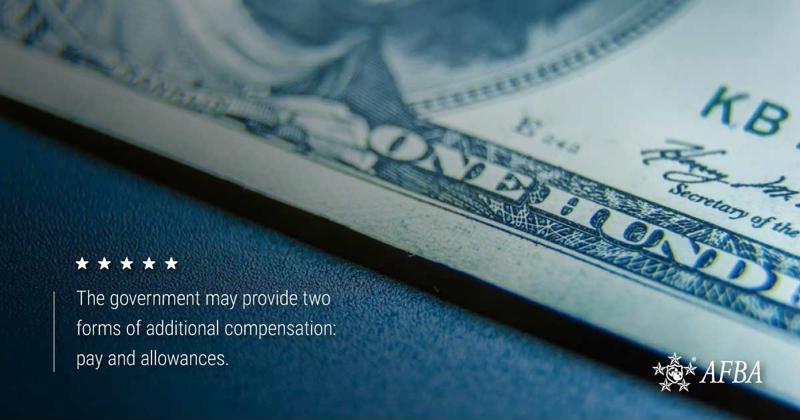Do you know what type of compensation you're eligible for as an active-duty servicemember? There are many possibilities based on your experience, assignments, location and more. Here, we'll break down the different kinds of military pay to help you get started on your financial planning for the future
Active duty basic pay
This is the primary form of income for active duty servicemembers and is similar to a civilian's paycheck. The government sends checks for basic pay every month, and servicemembers can expect an annual increase if approved by Congress. This is similar to a tenure-based raise or benefits increase that must be approved by upper management. This year, servicemembers saw their basic pay increase by 2.4 percent as of their Jan. 12 paycheck.

Other types of pay and allowances
Servicemembers often get other forms of compensation depending on various factors, including but not limited to:
- Professional skills.
- Area of assignment.
- Marital status.
- Types of duties performed.
It must be noted that the military provides general categories for two types of compensation:
Pay
Pay is generally subject to taxes and included in the taxable income reported to state and federal governments.
- Assignment Incentive Pay (AIP): Those who serve under unusual circumstances – such as involuntarily extended stay in Iraq, Afghanistan and even South Korea – may get financial compensation for their trouble.
- Career sea pay: Granted to active-duty sailors who have spent at least three years at sea. Amounts are based on the person's rank, and an additional $100 per month is granted for each subsequent month.
- Diving pay: Officers whose duties involve diving can receive up to $240 per month. Enlisted members with similar duties may receive up to $340 per month.
- Enlistment and reenlistment bonus: Those who initially enlist or extend their period of active duty are eligible for an Enlistment or Reenlistment bonus. The amount varies by skills and department but can be as much as $40,000.
- Foreign language proficiency pay: Those who maintain proficiency in certain languages (chosen by military departments) may receive a monthly payment of up to $1,000.
- Hardship duty pay (HDP): HDP-L payments, ranging from $50 to $150 are for officers and personnel serving in designated locations. HDP-M payments are for performing designated missions that involve recovering the remains of U.S. servicemembers.
- Hazardous duty incentive pay: Members who work in certain hazardous situations – including demolition, working with toxic fuel, flight deck operations and more – are authorized to receive $150 per month.
- Hostile fire and imminent danger pay: Servicemembers working in imminent danger zones are authorized to receive a $225 monthly payment.
- Involuntary separation pay: Members who are involuntarily and temporarily unable to serve (for reasons other than misconduct) and have served at least six – but no more than 20 years – of active duty are eligible for a special lump-sum.
- Medical pay: Medical specialists (doctors, dentists, nurses, pharmacist, physical therapists, radiation specialists, optometrists and others) are entitled to a variety of special pays.
- Special duty assignment pay: Servicemembers who perform duties with a high level of responsibility or that are extremely difficult can get a monthly payment ranging from $75 to $450.
Allowance
Allowance is not subject to taxation and not included in annual taxable income.
- Basic allowance for housing (BAH): Members not assigned to government quarters get a monthly allowance calculated to equalize out-of-pocket housing expenses, regardless of location. By 2019, members should only have to pay 5 percent of such costs from their own funds.
- Basic Allowance for Subsistence (BAS): Each month, officers get $254.39 and enlisted members authorized to mess separately get $369.39 to offset the cost of meals.
- Clothing Allowance: Officers get an initial uniform allowance, payable only once. Clothing replacement allowances are granted to members who must either wear civilian-type or special military clothing.
- Cost of living allowance for the continental United States (CONUS COLA): Servicemembers living in designated high-cost areas within the U.S. receive an allowance to offset non-housing costs. Most payments range from $20 to $300; sums are based on rank, dependent status, location and years of service.
- Dislocation allowance (DLA): Active-duty personnel dealing with a permanent change of station may have some of their moving expenses reimbursed. The amount depends on the member's grade and whether they have dependents.
- Family separation allowances (FSA): Only members with dependents may receive this allowance. There are three types: FSA-R (when dependents don't live nearby and the government won't expense their transportation), FSA-S (when the member is aboard a ship that is continuously away from more than 30 days) and FSA-T (when the member is on TDY or away from the permanent duty station for over 30 days).
- Overseas station allowances: This series of payments helps offset the costs for food, lodging and similar expenses when servicemembers are assigned outside the U.S. It consists of four components: cost of living allowance, overseas housing allowance, temporary lodging allowance and interim housing allowance.
- Temporary lodging expense (TLE): If a servicemember and/or dependents must stay in temporary lodgings while moving because of a permanent change of station, TLE partially offsets this cost and meal expenses.
Understanding your pay and allowances is the first step toward planning for your financial future. Armed Forces Benefit Association can help you with the rest.


